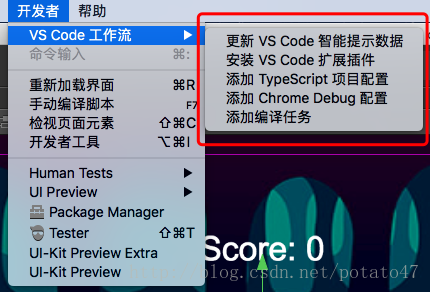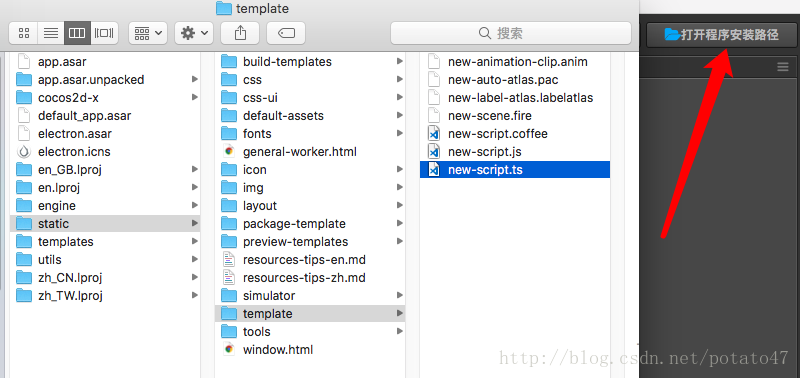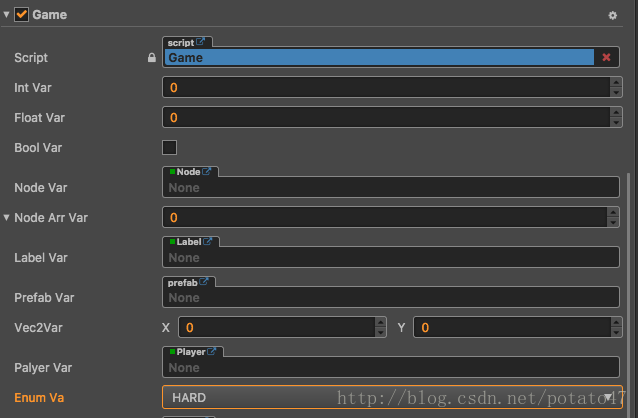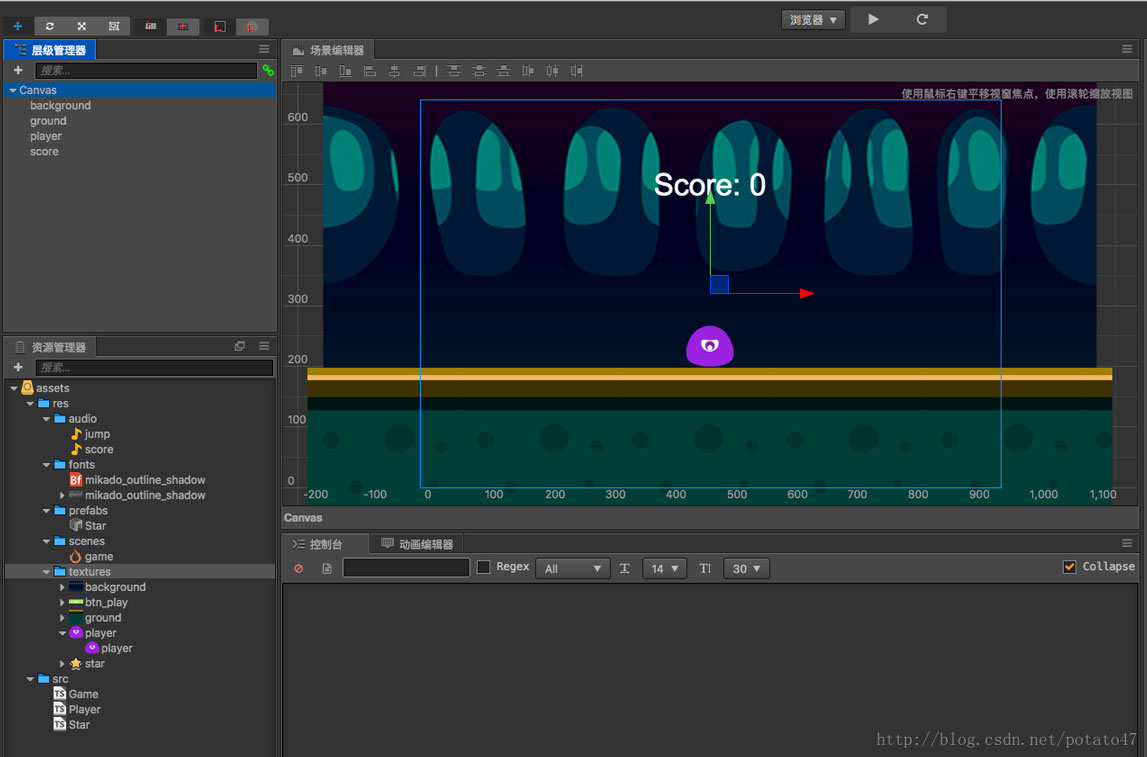目录
- 前提
- TypeScript VS JavaScript
- 代码编辑器选择
- 学习 TypeScript
- TypeScript 环境配置
- 配置自己的声明文件
- 属性类型声明
- 用 TypeScript 写一个游戏
前提
无论学什么技术知识,官方文档都应该是你第一个教程,所以请先至少阅读新手上路这一节 http://docs.cocos.com/creator/manual/zh/getting-started/ 再来看这篇文章。
这里假设你已经安装成功了 Cocos Creator。
TypeScript VS JavaScript
这里当然只会讲优点:
1. ts 是 js 的超集,所有 js 的语法 ts 都支持。
2. ts 支持接近完美的代码提示,js 代码提示接近于没有。
3. ts 有类型定义,编译时就可以排除很多无意义的错误。
4. ts 可以重构,适合大型项目。
5. ts 可以使用 es6 async之类的所有新语法。而 js Cocos Creator 还没有完全支持es6。
6. 最重要的一点:我以后的教程都会用 ts 写,如果你不用 ts,你就会永远失去我了。
代码编辑器选择
这里只推荐两个:
- Visual Studio Code
- WebStorm
vs code 的优点是快,与cocos creator 结合的好,一些功能需要自己安装插件。
webstorm 的优点是所有你想要的功能都先天内置了,缺点是占内存,个人感觉还有点丑。
对于我自己来说,我在公司用 WebStorm,在家用 VS Code。
如果你还是不知道用哪个,我只能先推荐你用VS Code 因为下面的内容是面向VS Code。
学习 TypeScript
既然要用ts开发游戏,肯定要知道ts的语法,我这一篇文章不可能把所有ts的语法都讲完,所以https://www.tslang.cn/docs/home.html,当然,不一定要一次性全看完,你可以先看个大概,遇到问题再补习。
TypeScript 环境配置
任意打开一个项目,把这几个都点一遍

控制台会输出

打开编辑器,你会发现一个名字为 creator.d.ts 的脚本

creator 的提示都依靠这个脚本,引擎的api变动也要及时更新这个脚本,所以每次更新引擎的时候都要重新点一次上面那个“更新VS Code只能提示数据“来重新生成creator.d.ts。
资源管理器右键新建一个ts脚本,点开后你会发现有很多没用的东西,而且还会有一个提示错误(1.81)。。。
// - [English] http://www.cocos2d-x.org/docs/editors_and_tools/creator-chapters/scripting/typescript/index.html
// Learn Attribute:
// - [Chinese] http://www.cocos.com/docs/creator/scripting/reference/attributes.html
// - [English] http://www.cocos2d-x.org/docs/editors_and_tools/creator-chapters/scripting/reference/attributes/index.html
// Learn life-cycle callbacks:
// - [Chinese] http://www.cocos.com/docs/creator/scripting/life-cycle-callbacks.html
// - [English] http://www.cocos2d-x.org/docs/editors_and_tools/creator-chapters/scripting/life-cycle-callbacks/index.html
const {ccclass, property} = cc._decorator;
@ccclass
export default class NewClass extends cc.Component {
@property(cc.Label)
label: cc.Label = null;
@property
text: string = 'hello';
// LIFE-CYCLE CALLBACKS:
// onLoad () {},
start () {
},
// update (dt) {},
}
编辑器右上角“打开程序安装路径“,

static-》template-》new-script.ts
这个脚本就是新建ts脚本的默认样式,我们来重新编辑一下,编辑后的脚本如下
const {ccclass, property} = cc._decorator;
@ccclass
export class NewClass extends cc.Component {
}
重新新建一个ts脚本,你会发现跟刚才编辑的默认脚本是一个样子了。
配置自己的声明文件
以d.ts为后缀名的文件,会被识别为声明文件,creator.d.ts是引擎的声明文件,我们也可以定义自己的声明文件,需要注意的是声明文件要放在assets文件外,因为assets文件里的脚本都会被引擎编译,而声明文件的作用就是写代码时提示一下,编译之后就不需要了。
举个栗子
在项目的根目录添加一个global.d.ts文件

然后在项目里的脚本就可以得到对应的提示


更多类型定义戳 https://www.tslang.cn/docs/handbook/declaration-files/introduction.html
属性类型声明
const LEVEL = cc.Enum({EASY:1,HARD:2});
@ccclass
export class Game extends cc.Component {
// 整型
@property(cc.Integer)
intVar: number = 0;
// 浮点型
@property(cc.Float)
floatVar: number = 0;
// 布尔型
@property(cc.Boolean)
boolVar: boolean = false;
// 节点
@property(cc.Node)
nodeVar: cc.Node = null;
// 节点数组
@property([cc.Node])
nodeArrVar: Array<cc.Node> = [];
// Label
@property(cc.Label)
labelVar: cc.Label = null;
// 预制体
@property(cc.Prefab)
prefabVar: cc.Prefab = null;
// 点
@property(cc.Vec2)
vec2Var: cc.Vec2 = cc.v2();
// 自定义节点
@property(Player)
palyerVar: Player = null;
// 重点来了,自定义枚举
/**
* 全局变量
* const LEVEL = cc.Enum({EASY:1,HARD:2});
*/
@property({
type:LEVEL
})
enumVa = LEVEL.EASY;
}

用 TypeScript 写一个游戏
最后我们来切身体会一下TypeScript的柔软丝滑。
挑一个熟悉的游戏来写,官方文档里有一个摘星星的游戏,我们用Ts重新写一下。
第一步:新建一个工程

第二步:写几个脚本
Game.ts
import { Player } from "./Player";
const { property, ccclass } = cc._decorator;
@ccclass
export class Game extends cc.Component {
// 这个属性引用了星星的预制资源
@property(cc.Prefab)
private starPrefab: cc.Prefab = null;
// 星星产生后消失时间的随机范围
@property(cc.Integer)
private maxStarDuration = 0;
@property(cc.Integer)
private minStarDuration = 0
// 地面节点,用于确定星星生成的高度
@property(cc.Node)
private groundNode: cc.Node = null;
// player 节点,用于获取主角弹跳的高度,和控制主角行动开关
@property(cc.Node)
public playerNode: cc.Node = null;
// score label 的引用
@property(cc.Label)
private scoreLabel: cc.Label = null;
// 得分音效资源
@property(cc.AudioClip)
private scoreAudio: cc.AudioClip = null;
// 地面节点的Y轴坐标
private groundY: number;
// 定时器
public timer: number;
// 星星存在的持续时间
public starDuration: number;
// 当前分数
private score: number;
protected onLoad() {
// 获取地平面的 y 轴坐标
this.groundY = this.groundNode.y + this.groundNode.height / 2;
// 初始化计时器
this.timer = 0;
this.starDuration = 0;
// 生成一个新的星星
this.spawnNewStar();
// 初始化计分
this.score = 0;
}
// 生成一个新的星星
public spawnNewStar() {
// 使用给定的模板在场景中生成一个新节点
let newStar = cc.instantiate(this.starPrefab);
// 将新增的节点添加到 Canvas 节点下面
this.node.addChild(newStar);
// 为星星设置一个随机位置
newStar.setPosition(this.getNewStarPosition());
// 将 Game 组件的实例传入星星组件
newStar.getComponent('Star').init(this);
// 重置计时器
this.starDuration = this.minStarDuration + cc.random0To1() * (this.maxStarDuration - this.minStarDuration);
this.timer = 0;
}
// 新星星的位置
public getNewStarPosition() {
let randX = 0;
// 根据地平面位置和主角跳跃高度,随机得到一个星星的 y 坐标
let randY = this.groundY + cc.random0To1() * this.playerNode.getComponent('Player').jumpHeight + 50;
// 根据屏幕宽度,随机得到一个星星 x 坐标
let maxX = this.node.width / 2;
randX = cc.randomMinus1To1() * maxX;
// 返回星星坐标
return cc.p(randX, randY);
}
// called every frame
protected update(dt: number) {
// 每帧更新计时器,超过限度还没有生成新的星星
// 就会调用游戏失败逻辑
if (this.timer > this.starDuration) {
this.gameOver();
return;
}
this.timer += dt;
}
// 得分
public gainScore() {
this.score += 1;
// 更新 scoreDisplay Label 的文字
this.scoreLabel.string = 'Score: ' + this.score.toString();
// 播放得分音效
// 不加as any就会报错,不信你试试
cc.audioEngine.play(this.scoreAudio as any, false, 1);
}
// gg
private gameOver() {
this.playerNode.stopAllActions(); //停止 player 节点的跳跃动作
cc.director.loadScene('game');
}
}
Player.ts
const { ccclass, property } = cc._decorator;
@ccclass
export class Player extends cc.Component {
// 主角跳跃高度
@property(cc.Integer)
private jumpHeight: number = 0;
// 主角跳跃持续时间
@property(cc.Integer)
private jumpDuration: number = 0;
// 最大移动速度
@property(cc.Integer)
private maxMoveSpeed: number = 0;
// 加速度
@property(cc.Integer)
private accel: number = 0;
// 跳跃音效资源
@property(cc.AudioClip)
private jumpAudio: cc.AudioClip = null;
private xSpeed: number = 0;
private accLeft: boolean = false;
private accRight: boolean = false;
private jumpAction: cc.Action = null;
private setJumpAction() {
// 跳跃上升
let jumpUp = cc.moveBy(this.jumpDuration, cc.p(0, this.jumpHeight)).easing(cc.easeCubicActionOut());
// 下落
let jumpDown = cc.moveBy(this.jumpDuration, cc.p(0, -this.jumpHeight)).easing(cc.easeCubicActionIn());
// 添加一个回调函数,用于在动作结束时调用我们定义的其他方法
let callback = cc.callFunc(this.playJumpSound, this);
// 不断重复,而且每次完成落地动作后调用回调来播放声音
return cc.repeatForever(cc.sequence(jumpUp, jumpDown, callback));
}
private playJumpSound() {
// 调用声音引擎播放声音
cc.audioEngine.play(this.jumpAudio as any, false, 1);
}
private addEventListeners() {
cc.systemEvent.on(cc.SystemEvent.EventType.KEY_DOWN, this.onKeyDown, this);
cc.systemEvent.on(cc.SystemEvent.EventType.KEY_UP, this.onKeyUp, this);
cc.find("Canvas").on(cc.Node.EventType.TOUCH_START, this.onScreenTouchStart,this);
cc.find("Canvas").on(cc.Node.EventType.TOUCH_CANCEL, this.onScreenTouchEnd, this);
cc.find("Canvas").on(cc.Node.EventType.TOUCH_END, this.onScreenTouchEnd,this);
}
private moveLeft() {
this.accLeft = true;
this.accRight = false;
}
private moveRight() {
this.accLeft = false;
this.accRight = true;
}
private stopMove() {
this.accLeft = false;
this.accRight = false;
}
private onScreenTouchStart(event: cc.Event.EventTouch) {
if (event.getLocationX() > cc.winSize.width/2) {
this.moveRight();
} else {
this.moveLeft();
}
}
private onScreenTouchEnd() {
this.stopMove();
}
private onKeyDown(event: cc.Event.EventKeyboard) {
switch ((event as any).keyCode) {
case cc.KEY.a:
case cc.KEY.left:
this.moveLeft();
break;
case cc.KEY.d:
case cc.KEY.right:
this.moveRight();
break;
}
}
private onKeyUp(event: cc.Event.EventKeyboard) {
switch ((event as any).keyCode) {
case cc.KEY.a:
case cc.KEY.left:
this.stopMove();
break;
case cc.KEY.d:
case cc.KEY.right:
this.stopMove();
break;
}
}
// use this for initialization
protected onLoad() {
// 初始化跳跃动作
this.jumpAction = this.setJumpAction();
this.node.runAction(this.jumpAction);
// 加速度方向开关
this.accLeft = false;
this.accRight = false;
// 主角当前水平方向速度
this.xSpeed = 0;
// 初始化输入监听
this.addEventListeners();
}
// called every frame
protected update(dt: number) {
// 根据当前加速度方向每帧更新速度
if (this.accLeft) {
this.xSpeed -= this.accel * dt;
} else if (this.accRight) {
this.xSpeed += this.accel * dt;
}
// 限制主角的速度不能超过最大值
if (Math.abs(this.xSpeed) > this.maxMoveSpeed) {
// if speed reach limit, use max speed with current direction
this.xSpeed = this.maxMoveSpeed * this.xSpeed / Math.abs(this.xSpeed);
}
// 根据当前速度更新主角的位置
this.node.x += this.xSpeed * dt;
if (this.node.x <= -this.node.parent.width / 2) {
this.node.x = this.node.parent.width / 2;
}
if (this.node.x > this.node.parent.width / 2) {
this.node.x = -this.node.parent.width / 2;
}
}
}
Star.ts
import { Game } from "./Game";
const {ccclass,property} = cc._decorator;
@ccclass
export class Star extends cc.Component {
// 星星和主角之间的距离小雨这个数值时,就会完成收集
@property(cc.Integer)
private pickRadius: number = 0;
private game: Game = null;
public init(game:Game) {
this.game = game;
}
getPlayerDistance() {
// 根据 player 节点位置判断距离
let playerPos = this.game.playerNode.getPosition();
// 根据两点位置计算两点之间距离
let dist = cc.pDistance(this.node.position, playerPos);
return dist;
}
onPicked() {
// 当星星被收集时,调用 Game 脚本中的接口,生成一个新的星星
this.game.spawnNewStar();
// 调用 Game 脚本的得分方法
this.game.gainScore();
// 然后销毁当前星星节点
this.node.destroy();
}
// called every frame
update(dt:number) {
// 每帧判断和主角之间的距离是否小于收集距离
if (this.getPlayerDistance() < this.pickRadius) {
// 调用收集行为
this.onPicked();
return;
}
// 根据 Game 脚本中的计时器更新星星的透明度
let opacityRatio = 1 - this.game.timer/this.game.starDuration;
let minOpacity = 50;
this.node.opacity = minOpacity + Math.floor(opacityRatio * (255 - minOpacity));
}
}
以上就是CocosCreator入门教程之用TS制作第一个游戏的详细内容,更多关于CocosCreator TS制作游戏的资料请关注自由互联其它相关文章!
